Lacquer is an excellent finish for your furniture which helps to get a shiny coat with great waterproofing qualities.
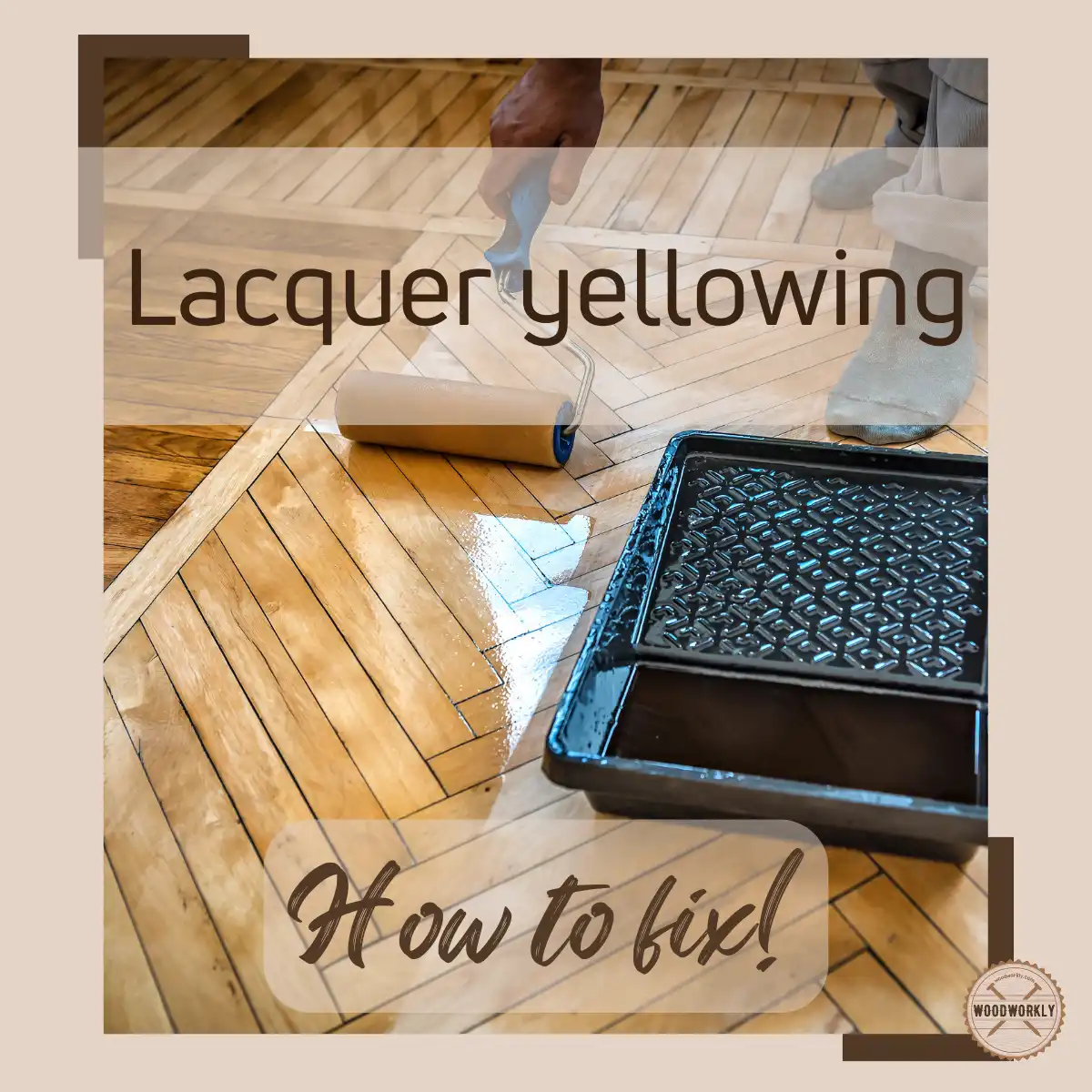
But after many years of use, you may notice a difference in your beautiful lacquer-coated furniture surfaces just like yellowing.
I was curious to know whether lacquer finish turns yellows like other oil-based finishes and did some research on that with the help of experts.
Now with years of experience in wood finishing, let me share with you what I know about lacquer finish.
So, let’s find out, Does Lacquer yellow
Yes, Lacquer does yellow over time when exposed to sunlight or other natural elements. Nitrocellulose lacquer yellows over time since it is oil-based. But acrylic lacquer is water-based, and it never yellows. To fix the lacquer that turned yellow, strip and sand the yellowed lacquer and refinish with a non-yellowing lacquer finish.
But there’s more to know!

So, in this article, I’ll explore does lacquer yellow and what is the reason for that.
I’ll tell you how to fix yellowed lacquer, how to apply lacquer to avoid getting yellow stains, and more tips and tricks.
Furthermore, I’ll answer some frequently asked questions as well.
Let’s jump in!
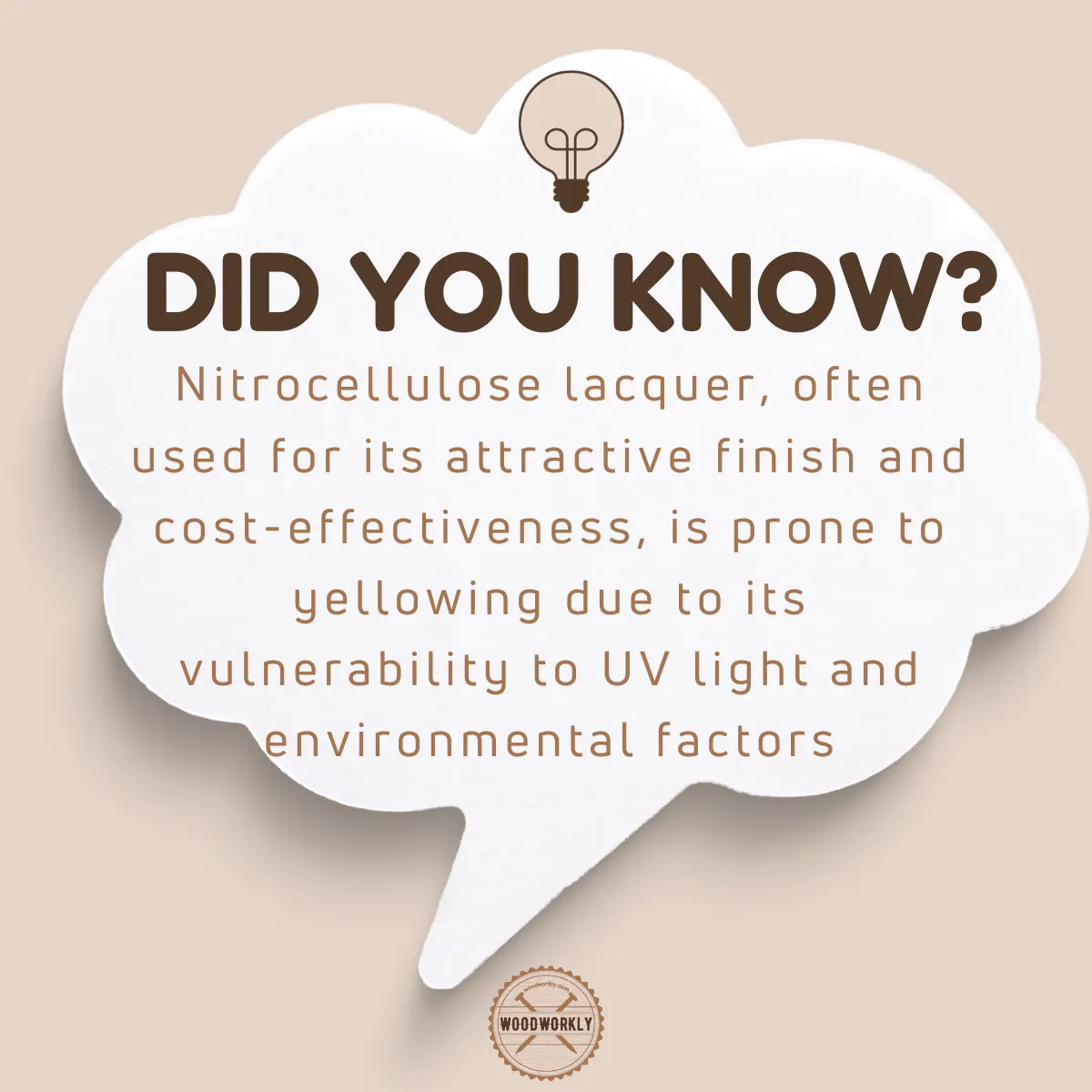
Why Does Lacquer Yellow?
Not all lacquer types are yellow over time. Only the nitrocellulose lacquer yellows over time. CAB-Acrylic lacquer never yellows.
Nitrocellulose lacquer yellows because it is an oil-based finish. With exposure to direct sunlight and other environmental elements, nitrocellulose lacquer tends to yellow over time.
Acrylic lacquer doesn’t yellow since it is a water-based finish. It dries “water white” which means never yellows over time.
But nitrocellulose lacquer is much more popular than acrylic lacquer since it gives prettier look for a cheap price. But on the other hand, it is prone to yellowing over time.
If you apply nitrocellulose lacquer over furniture that doesn’t expose to direct sunlight, the lacquer finish won’t yellow easily for couple more years.
But nothing can change the fact that nitrocellulose lacquer is an oil-based finish and oil-based finishers will yellow sooner or later due to aging, sunlight, UV light, and other various reasons.
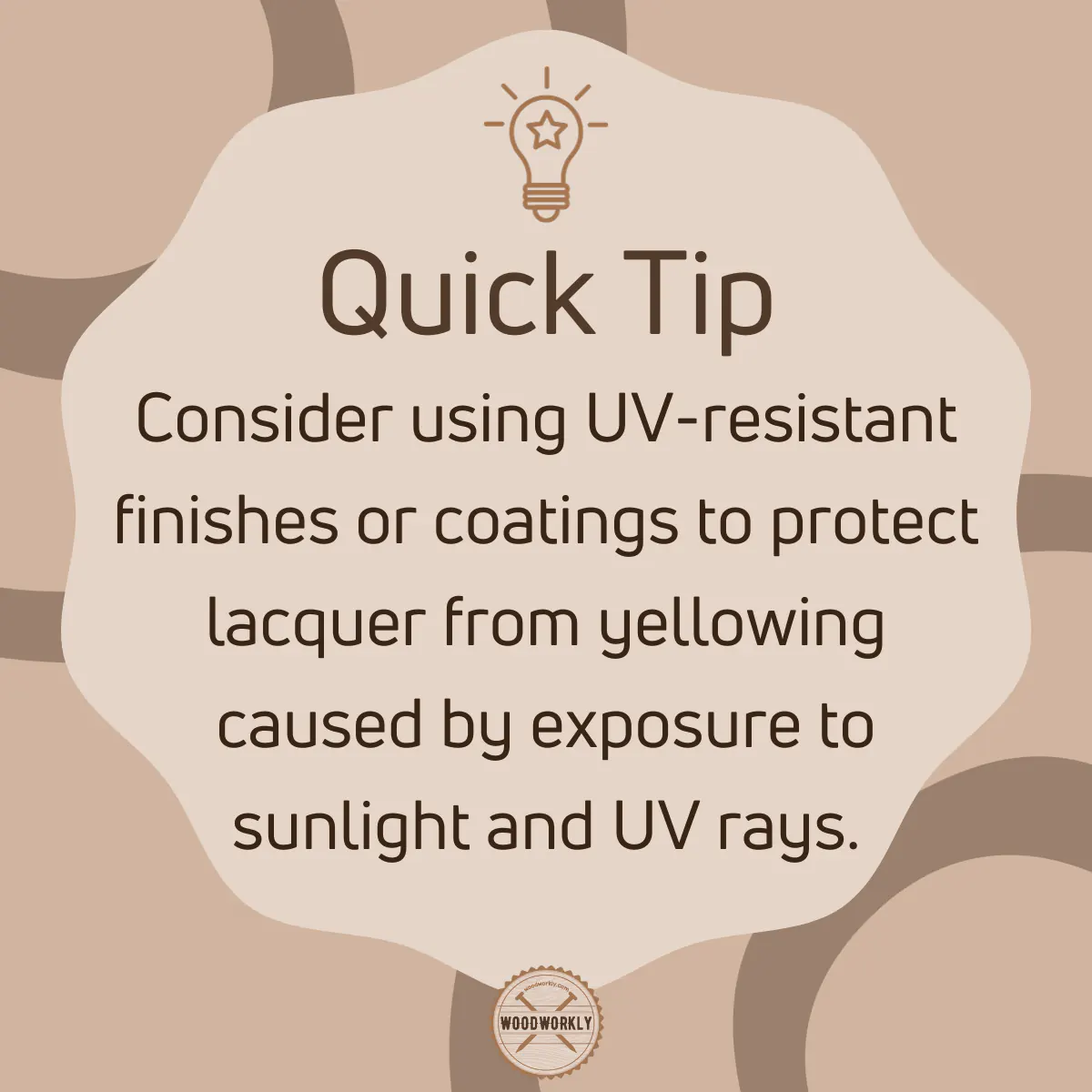
Some manufacturers say they have nitrocellulose lacquer with UV protection in it. But having UV protection only helps to keep its color natural for several years.
After that, the UV protection will eventually fade away and the lacquer coat will start yellowing upon exposure to sunlight.
Nitrocellulose lacquer contains alkyd/nitrocellulose resins dissolved in fast-evaporating solvents.
Nitrocellulose lacquers are sensitive to heat and chemical substances. When it gets exposed to direct sunlight, nitrocellulose lacquer molecules will break causing yellowing on the surface.
Exposure to sunlight accelerates the yellowing process of lacquer. Nitrocellulose lacquer yellows as it ages and especially under sunlight.
The more sunlight lacquer gets, the faster it yellows.
Therefore, better to apply CAB-Acrylic lacquer to furniture that exposes to sunlight and for outdoor woodworking projects to prevent surface yellowing over time.
Use nitrocellulose lacquer which is also known as regular lacquer for indoor furniture and woodwork that isn’t exposed to the sunlight directly.
Ultimately, an oil-based lacquer finish (nitrocellulose lacquer) reacts with UV rays and yellows over time. Water-based lacquer (CAB-Acrylic lacquer) is stable and stays its true color for so long.
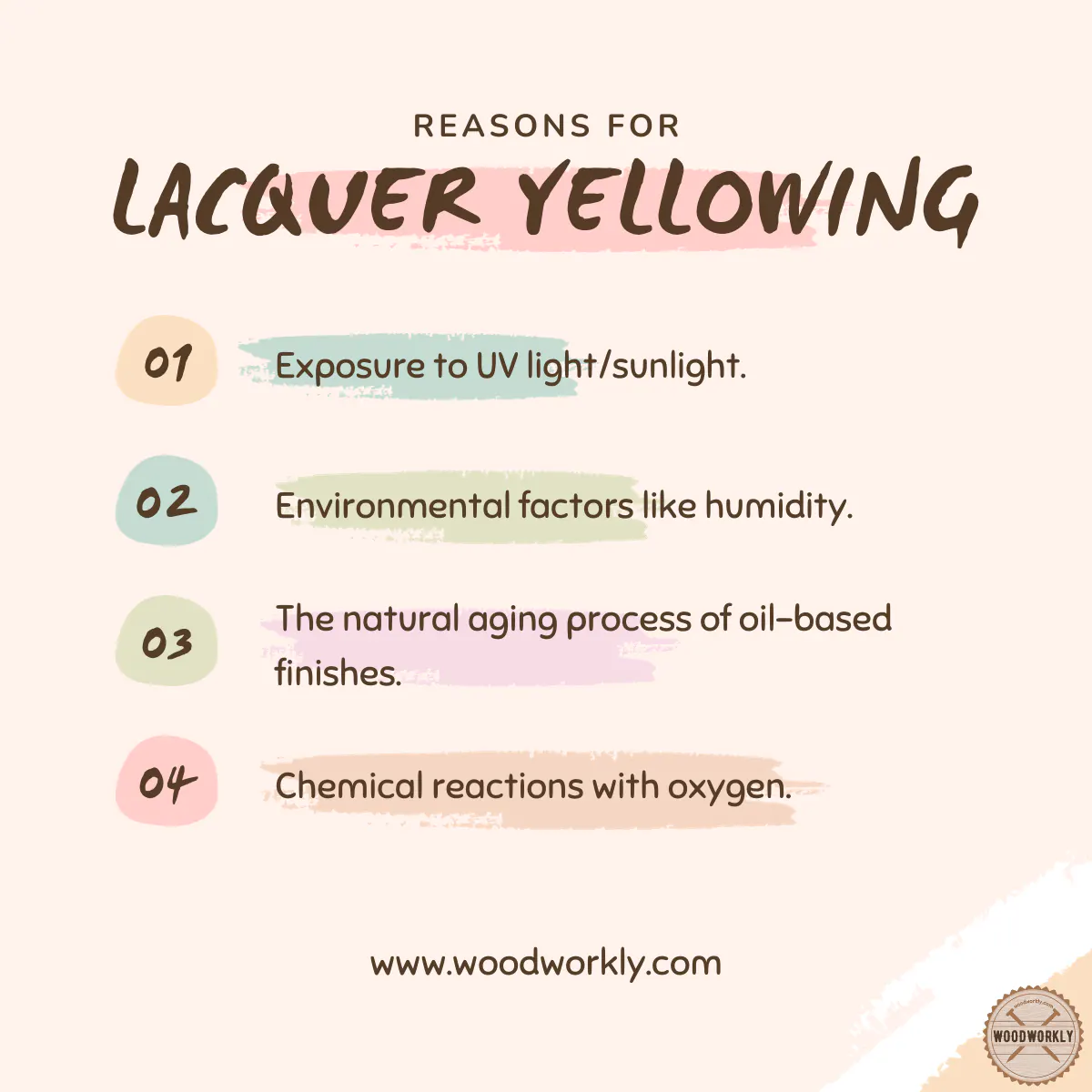
So, let’s find out how to fix the lacquer turned yellow.
How To Fix Lacquer Turned Yellow?
Fixing yellowed lacquer is easy only if you follow the correct procedure. Otherwise, you’ll probably end up with ugly looking finish with no protection from outside elements like moisture.
There’re main 3 methods of fixing lacquer that turned yellow. They are,
- Apply a new coat of lacquer over the previous one
- Scuff the old finish and spray a new coat
- Strip the old finish and refinish with non-yellowing lacquer
- Remove yellowed areas with lacquer thinner
So, let’s discuss each of the above methods in detail to know fixing yellowing lacquer with ease.
1. Apply a New Coat of Lacquer Over The Previous One
Applying a new coat of nitrocellulose lacquer finish over the previous yellowed lacquer coat is the easiest method to fix the lacquer turned yellow.
Even though this method is super easy, it is not much effective since the newly applied lacquer coat will also yellow after a couple of years.
Plus, the thickness of lacquer coats will also get higher and that can be an issue when drying.
Poor drying between lacquer coats blocks moisture evaporation and makes the lacquer finish cloudy.
This method is useful when your previous lacquer coat is super thin and if you’re willing to place the furniture in a covered area without letting it hit by sunlight after the application of a new lacquer finish over the yellowed one.
Otherwise, theirs is no use in applying another lacquer coat over the yellowed one since the new lacquer coat will also start yellowing upon exposure to sunlight and other elements.
Plus, it will give a dull unnatural appearance to the wood.
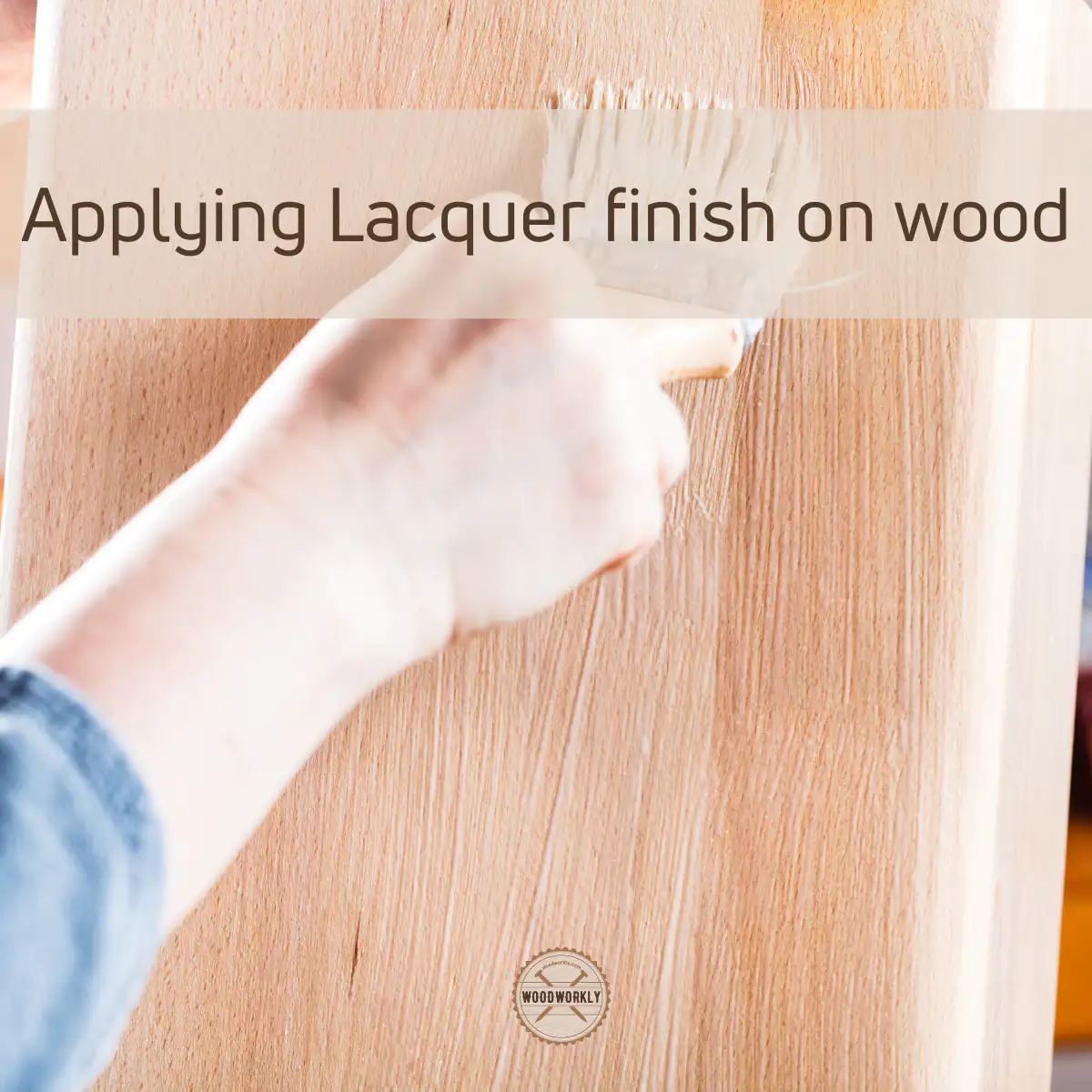
2. Scuff The Old Finish
You can scuff the old, yellowed lacquer surface with 220 grit sandpaper and spray new non-yellowing lacquer on top of that to fix the lacquer that turned yellow.
This method is great for surfaces with random yellowed lacquer patches.
Those random yellowed lacquer areas can be scuffed with 220 grit sandpaper until the yellow tone goes away and then spray new non-yellowing lacquer on top of that.
This method is best for surfaces that only have randomly yellowed lacquer patches.
The scuffing method is not good for surfaces with a completely yellowed lacquer finish since sanding the entire surface can damage the wood and removing the yellow tone is also can be difficult.
The old, yellowed lacquer finish will be softened when scuffing and coating with a new coat.
By applying a new lacquer coat, you will be able to eliminate not only the yellowing lacquer but also small cracks and scratches on the surface.
This method will provide a glowing lacquer finish with no yellow patches at all.
Make sure to spray CAB-Acrylic lacquer over the previous old finish since it won’t yellow over time.
3. Strip and Sand The Yellowed Finish and Refinish
This is the most effective and ideal method to fix lacquer turned yellow. To fix the yellowing lacquer, you need to strip and sand the yellowed lacquer coat completely and refinish by applying a non-yellowing lacquer finish.
Yes, this method is time-consuming. But using this method you won’t be able to see yellowed lacquer surface ever.
By stripping and sanding the previously applied yellow lacquer surface and refinishing with a new non-yellowing lacquer you’ll be able to get a thin coat of lacquer that dries and cures faster.
Let’s have a look at the procedure for fixing the yellowed lacquer finish with simple steps.
Supplies You Will Need,
- Chemical stripper (Methylene chloride, Toluene, Acetone, Ketones, Denatured alcohol, Mineral spirits)
- 80-grit sandpaper
- 150-grit sandpaper
- 220-grit sandpaper
- Damp cloth
- Non-yellowing lacquer (CAB-Acrylic lacquer)
Here are the steps you need to follow when fixing yellowing lacquer,
- Strip the old, yellowed finish
- Sand the old finish
- Apply non-yellowing finish
So, let’s discuss each of the above steps in-detail to get a better idea about fixing the yellowed lacquer finish.
1. Strip The Old, Yellowed Finish
First, you need to strip the yellowed lacquer finish from A to Z.
To do this apply a chemical stripper all over the yellowed lacquer surface. Then the chemical stripper sits on a yellowed surface for a few minutes to do the job.
During this period, the chemical stripper reacts with the yellowed lacquer surface and tone down the yellow, and break the bond between the wooden surface and lacquer layers.
This helps to remove old lacquer layers with ease because a chemical stripper will break the bonds of the lacquer finish.
After several minutes wipe down the excess chemical strippers on the surface and let the surface dry for a few minutes.
Now you can easily remove the old lacquer finish using sandpapers.
2. Sand The Old Finish
Now sand the entire surface starting with 80 grit sandpaper to remove the old finish completely and smoothen the surface.
Sand the entire wood with coarse 80-grit sandpaper in a power sander or manual sander.
Apply even pressure on sandpaper to remove the old finish without scratching the wood surface.
Then sand the entire surface with 150-grit sandpaper and then with 220-grit sandpaper to remove the old finish completely, smoothen the surface and make the surface ready to take a new finish.
Make sure to wipe the surface between each sanding to remove sawdust and residue from the old finish.
Once you’re done with sanding remove dust using a proper dust collection pipe system or wipe the entire surface without letting dust sit on the surface.
Dust should not mix with the new finish since it will give a dull, ugly appearance.
Now your wooden surface is ready to take a new look with a fresh non-yellowing lacquer finish.
Tip: You may need to bleach the wood if you have noticed the wooden surface is also yellowed because of the old, yellowed lacquer finish.
Having a neutral color surface is a must to get the best from a lacquer finish.
3. Apply Non-Yellowing Finish
Non-apply non-yellowing lacquer finish by brushing or spraying all over the wooden surface without missing any spots.
Apply Acrylic lacquer as a non-yellowing lacquer finish, they are water-based and won’t turn yellow over time like nitrocellulose lacquer finish.
Apply thin coats of lacquer along the direction of the wood grain to get an evenly spread nice finish.
After applying lacquer completely all over the wood, let the surface dry and cure to get the best appearance.
Now your furniture won’t be yellow again and a fresh lacquer surface is able to protect the wood while keeping the surface “water white” for so long.
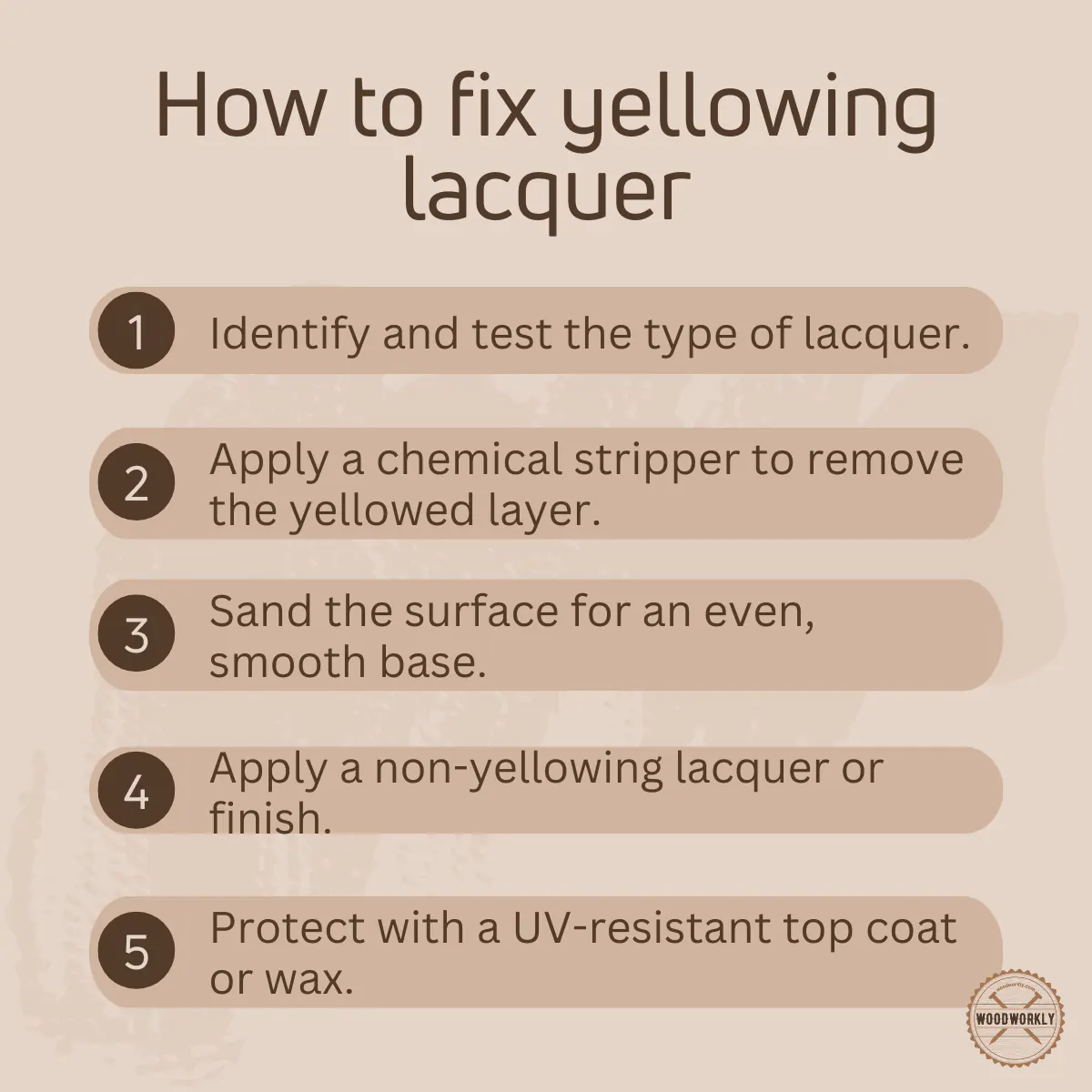
4. Remove Yellowed Ares With Lacquer Thinner
if you’ve noticed a few areas that were yellowed over time, you can clean the yellowed lacquer areas with lacquer thinner.
Here’s the procedure for cleaning the yellowed lacquer finish
- Mix one part of lacquer thinner with two parts of denatured alcohol
- Apply the mixture to the yellowed areas of the lacquer finish
- Rub the areas until the yellow tone is gone
- Rince the areas with water
- Wipe the excess with a damp cloth
- Let the areas dry and see the difference
This is a quick, simple, and efficient method to clean yellowed lacquer areas with ease without stripping the whole finish.
This method can be applied for decorative items and small woodworking projects to do the job easily.
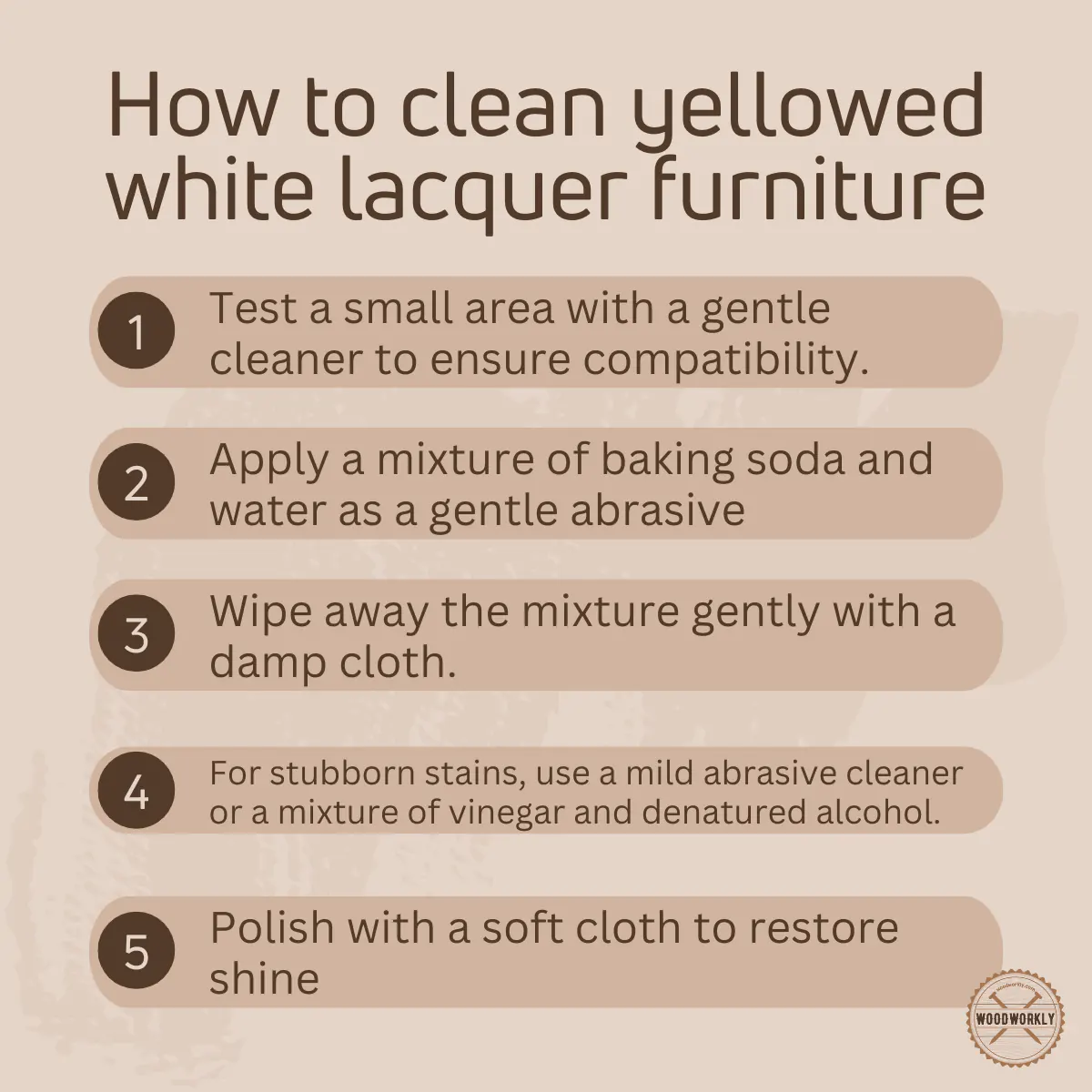
Non-Yellowing Finishes
In order to protect your furniture and woodwork from yellowing, better to go for non-yellowing finishes which won’t change the wood color for so long.
Most of the non-yellowing finishes are water-based and yellowing is a common thing for oil-based finishes.
Therefore, always go for a water-based finish to protect your furniture from yellowing.
Here’s a list of the best non-yellowing finishes,
- Acrylic lacquer
- Polyurethane varnish
- Epoxy resin
- Polycrylic
- Shellac
That’s it, folks! Now you have a clear idea about, does lacquer yellow and how to fix yellowing lacquer with simple methods.
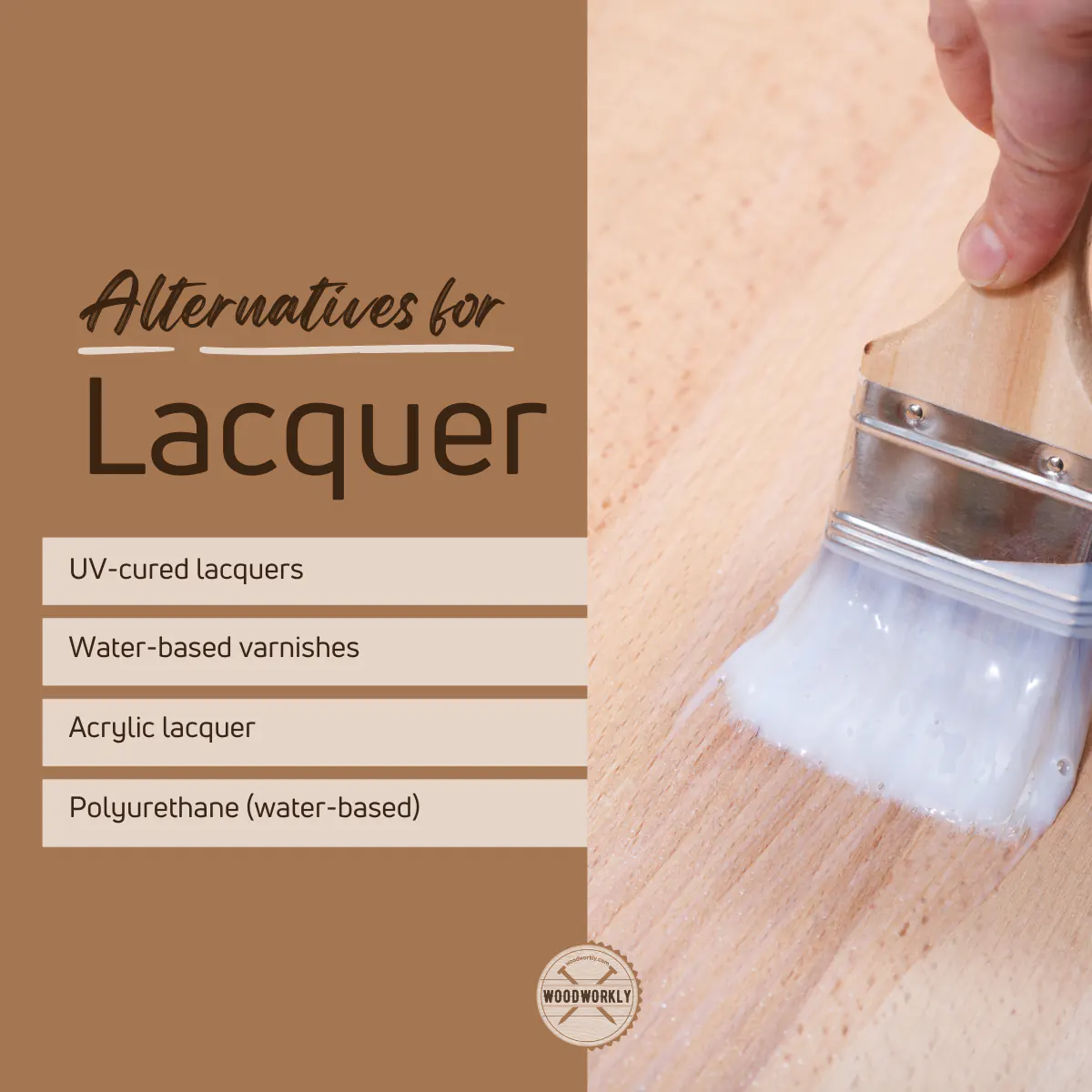
What Lacquer Does Not Yellow?
ACB-Acrylic lacquer does not yellow over time since it is a water-based finish. Acrylic lacquer does not discolor the wood and is able to keep its original color for so long.
You can fic yellowed nitrocellulose lacquer finish by stripping, sanding, and refinishing with non-yellowing acrylic lacquer.
For woodwork that is exposed to sunlight and outdoor furniture, the ideal choice is acrylic lacquer since it doesn’t react with UV light or other chemical substances that cause yellowing.
Does Clear Lacquer Yellow Over Time?
Yes, clear lacquer yellows over time upon exposure to direct sunlight and chemical substances. Nitrocellulose lacquer molecules break upon UV light and cause yellowing.
Apply acrylic lacquer to prevent yellowing time which is water-based, durable, and able to apply for furniture that faces direct sunlight.
How Long Does It Take Lacquer To Yellow?
Lacquer may take 5 years or longer to yellow over time. But this depends on the amount of sunlight exposure to the lacquered surface.
If the surface does not hit by direct sunlight, it may not be yellow even up to 10 – 15 years.
Lacquer reacts with UV rays and oxygen in the air which leads to a dramatic color change.
Does Deft lacquer Yellow?
Deft lacquer does not yellow over time. it remains the same color for so long with no discoloration.
It gives a clear color to the wood and dries faster with 20 – 40 minutes. Mostly deft lacquer is applied for interior furniture with minimum exposure to sunlight.
Does Shellac Yellow?
No, Shellac does not yellow over time since it has excellent UV resistance which is able to keep the original color for so long with no discoloration.
Shellac is ideal for indoor and outdoor furniture to keep them as fresh as new.
Shellac is a non-yellowing finish that provides scratch and dent resistance to furniture and other woodwork.
It is one of the best alternative finishers for yellowing finishers like Lacquer and Tung oil finish.
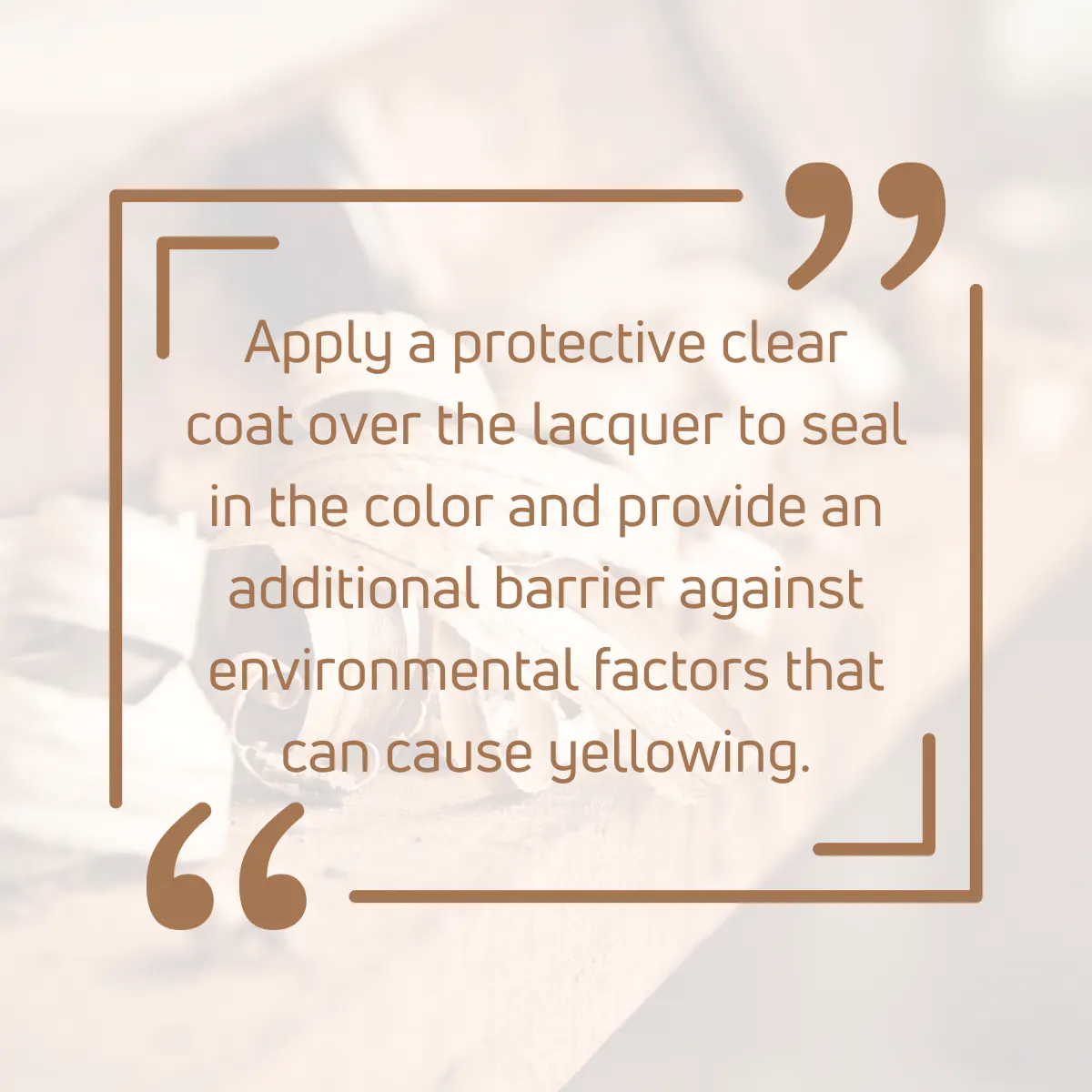
Let’s answer some frequently asked questions.
FAQs
Does all lacquer turn yellow over time?
Not all lacquers turn yellow; water-based lacquers like CAB-Acrylic and UV-cured lacquers generally remain clear and do not yellow over time, while oil-based nitrocellulose lacquers are prone to yellowing due to exposure to UV light and environmental factors.
What causes lacquer to yellow?
Lacquer, especially nitrocellulose, tends to yellow as it reacts with UV light rays, environmental elements, and certain chemicals, leading to a breakdown in its molecular structure and a change in color.
How can yellowing of lacquer be prevented?
Yellowing can be minimized by using non-yellowing types of lacquers, such as CAB-Acrylic or UV-cured lacquers, and by protecting the lacquered items from direct sunlight and extreme environmental conditions.
How to clean yellowed lacquer?
Yellowed lacquer can be cleaned using a mixture of baking soda and water or a combination of vinegar and denatured alcohol, applied gently with a soft cloth, to restore its original appearance.
Does Deft lacquer yellow over time?
Deft lacquer is known for its exceptional color retention properties and resistance to yellowing, making it a popular choice for interior wood finishes.
Is there a way to reverse the yellowing of polyurethane varnish?
es, the yellowing can often be reversed by stripping the old finish using a chemical stripper appropriate for the type of varnish, then refinishing the surface with a non-yellowing product.
Did I cover all you wanted to know about: Does Lacquer Yellow
In this article, I have deeply discussed, does lacquer yellow, what type of lacquer yellow is, and how to fix yellowed lacquer with simple methods and tricks.
Nitrocellulose lacquer yellows over time since it is an oil-based finisher. Acrylic lacquer is non-yellowing and provides a clear finish. To fix the yellowing lacquer, strip and sand the old, yellowed lacquer finish and refinish with a non-yellowing lacquer finish. Or scuff the yellowed lacquer with 220-grit sandpaper.
Furthermore, I’ve answered some frequently asked questions as well.
Hope you have gained good knowledge about, does lacquer yellow and how to fix yellowed lacquer effectively.
Try to use acrylic lacquer instead of regular nitrocellulose lacquer for your next woodworking project to keep the furniture in its original color for so long with no yellowing.